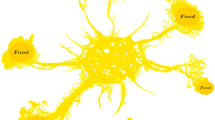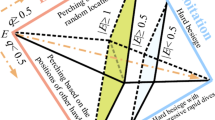Abstract
The problem of injection molding machine’s multi-objective optimization is very important. A triple-objective optimization model with the largest mould moving speed and injecting capacities and the smallest injecting power has been created. The optimized design constraints of the optimal model are summarized. The computational efficiency of Strength Pareto Evolutionary Algorithm (SPEA) is improved by using rough set-based support vector clustering method. The number of external stocks is reduced. The optimal Pareto solution is determined by eliminating the uncertainty in the artificial priority election. The multi-objective optimization of the HT1600X1N injection molding machine is taken as an example. The SPEA-RSVC-II which is the mixed algorithm of Strength Pareto Evolutionary Algorithm and Ro′ugh-based Support Vector Clustering is applied. It shows that the new method could accelerate the population clustering operation effectively and improves the efficiency of optimized calculation.
Similar content being viewed by others
References
Knowles J, Corne D (2003) Properties of an adaptive archiving algorithm for storing nondominated vectors. IEEE Trans Evol Comput 7(2):100–116. doi:10.1109/TEVC.2003.810755
Debasis S, Jayant M (2005) Pareto-optimal solutions for multi-objective optimization of fed-batch bioreactors using nondominated sorting genetic algorithm. Chem Eng Sci 60(3):481–492
Fonseca CM, Fleming PJ (1995) An overview of evolutionary algorithms in multi-objective optimization. Evol Comput 3(1):1–16. doi:10.1162/evco.1995.3.1.1
Srinivas N, Deb K (1994) Multiobjective optimization using nondominated sorting in genetic algorithms. Evol Comput 2(3):221–248. doi:10.1162/evco.1994.2.3.221
Deb K, Pratap A, Agarwal S (2002) A fast and elitist multiobjective genetic algorithm: NSGA-II. IEEE Trans Evol Comput 6(2):182–197. doi:10.1109/4235.996017
Horn J, Nafpliotis N, Goldberg DE (1994) A Niched Pareto Genetic Algorithm for Multiobjective Optimization. In: Proceedings of the First IEEE Conference on Evolutionary Computation, IEEE World Congress on Computational Intelligence, vol. 11 Piscataway, New Jersey
Corne DW, Knowles JD, Oates MJ (2000) The Pareto Envelopebased Selection Algorithm for Multiobjective Optimization. In: Proceedings of the Parallel Problem Soving from Nature VI Conference. Paris, France
Zitzler E, Thiele L (1999) Multiobjective evolutionary algorithms: a comparative case study and the strength Pareto approach. IEEE Trans Evol Comput 3(4):257–271. doi:10.1109/4235.797969
Lun GC, Chueh CH (2004) Multi-objective optimal design of truss structure with immune algorithm. Comput Struc 82(11–12):829–844. doi:10.1016/j.compstruc.2004.03.003
Liu YM, Wang CJ (1999) A modified genetic algorithm based optimisation of milling parameters. Int J Adv Manuf Technol 18(15):796–799. doi:10.1007/s001700050134
Wang N (1993) Multiple-objective optimization of machining operations based on neural networks. Int J Adv Manuf Technol 12(8):235–243. doi:10.1007/BF01748633
Jerald J, Asokan P, Prabaharan G, Saravanan R (2005) Scheduling optimisation of flexible manufacturing systems using particle swarm optimisation algorithm. Int J Adv Manuf Technol 24(25):964–971. doi:10.1007/s00170-003-1933-2
Jaewook L, Daewon L (2005) An improved cluster labeling method for support vector clustering. IEEE Trans Pattern Anal Mach Intell 27(3):461–464. doi:10.1109/TPAMI.2005.47
Wigotsky V (2001) Injection molding machinery. Plastics Eng 57(12):342–371
Schlottmann F, Seese D (2004) Financial applications of multi-objective evolutionary algorithms: Recent developments and future research directions. In: Coello CAC, Lamont GB (eds) Applications of multi-objective evolutionary algorithms. World Scientific, Singapore
Sankar SS, Ponnambalam SG, Gurumarimuthu M (2006) Scheduling flexible manufacturing systems using parallelization of multi-objective evolutionary algorithms. Int J Adv Manuf Technol 30(3–4):279–285. doi:10.1007/s00170-005-0045-6
Knowles JD, Corne DW (2000) Approximating the nondominated front using the Pareto archived evolution strategy. Evol Comput 8(2):149–172. doi:10.1162/106365600568167
Kitayama S, Arakawa M, Yamazaki K (2006) Penalty function approach for the mixed discrete nonlinear problems by particle swarm optimization. Struct Multidisciplinary Optim 32(3):191–202. doi:10.1007/s00158-006-0021-2
Abido MA (2006) Multiobjective evolutionary algorithms for electric power dispatch problem. IEEE Trans Evol Comput 10(3):315–329. doi:10.1109/TEVC.2005.857073
Laumanns M, Thiele L, Deb K (2002) Combining convergence and diversity in evolutionary multi-objective optimization. Evol Comput 10(3):263–282. doi:10.1162/106365602760234108
Purshouse RC (2003) On t he Evolutionary Optimisation of Many Objectives: [PhD thesis]. Sheffield, U K:Department of Automatic Control and Systems Engineering, The University of Sheffield
Hirani H (2004) Multiobjective optimization of a journal bearing using the Pareto optimality concept. J Eng Tribology 218(4):323–336
Author information
Authors and Affiliations
Corresponding author
Rights and permissions
About this article
Cite this article
Wei, Z., Yang, D., Wang, X. et al. Multi-objectives optimal model of heavy equipment using improved Strength Pareto Evolutionary Algorithm. Int J Adv Manuf Technol 45, 389–396 (2009). https://doi.org/10.1007/s00170-009-1962-6
Received:
Accepted:
Published:
Issue Date:
DOI: https://doi.org/10.1007/s00170-009-1962-6




